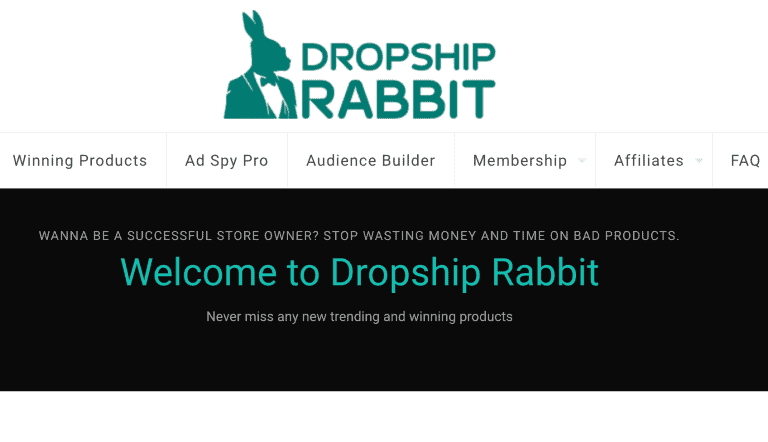Make Review 2025 — Pricing, Features, Integrations, Pros & Cons
Automation is important for businesses that want to save time, cut costs, and scale faster. Make, formerly known as Integromat, has become one of the best automator competing directly with Zapier, n8n, and Workato. It is recognized for its visual approach and its ability to manage both simple tasks and highly complex workflows using AI.
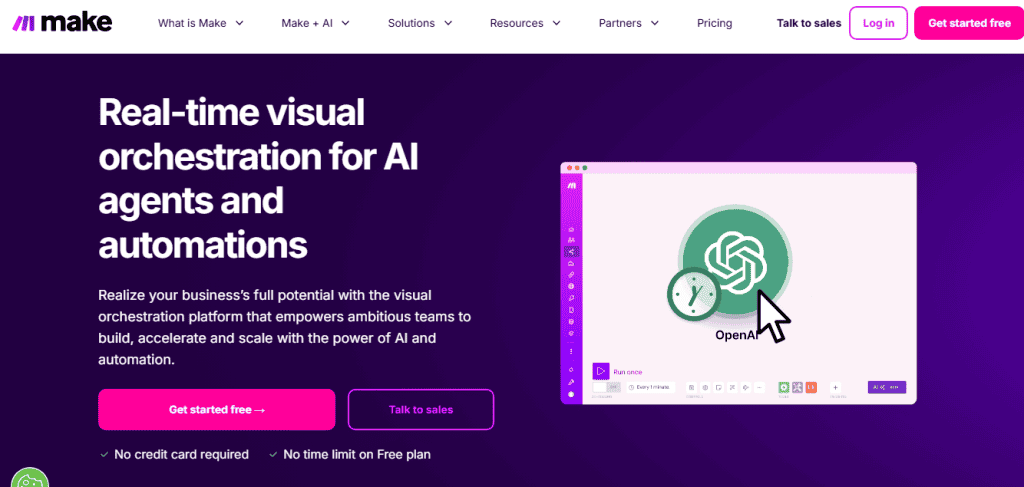
In this review, we will take a close look at what Make offers in 2025. We will check its main features, pricing structure, AI capabilities, and compare it with alternatives. By the end, you will have a clear idea of whether Make is the right automation platform for your needs.
What is Make?
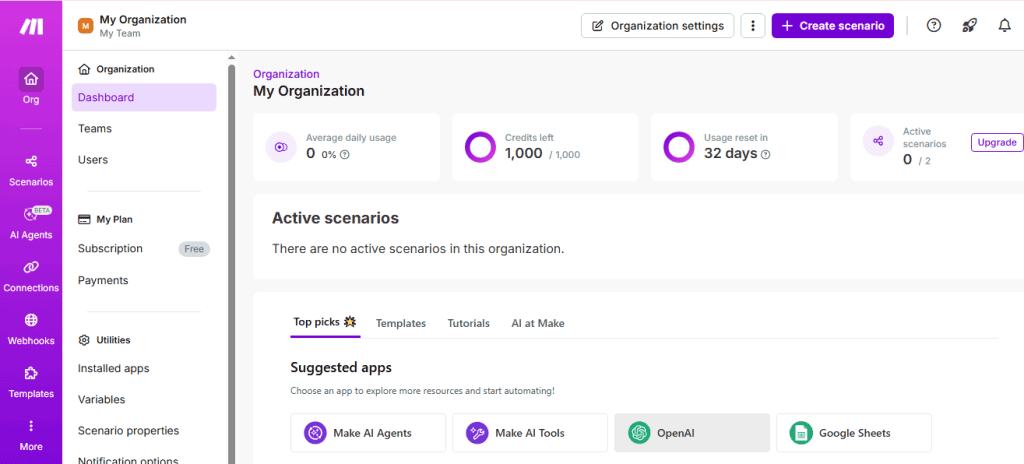
Make is an automation platform you can use to build, manage, and scale workflows through a visual interface with little or no code. You don’t need long lists of text-based triggers and actions, Make uses a drag-and-drop scenario builder where you can connect apps and define conditions in real time.
Originally, it’s launched as Integromat and later rebranded to Make to highlight its wider mission of both automation and AI-driven orchestration. Today, it supports over 350,000 customers and includes more than 2,500 prebuilt applications along with 400 integrations specifically for AI tools.
Some key aspects of Make are the visual scenario builder, combination of automation with AI agents, its scalability for businesses of different sizes, and its enterprise-level governance.
Core Features of Make
Below are the key features that define Make’s platform in 2025.
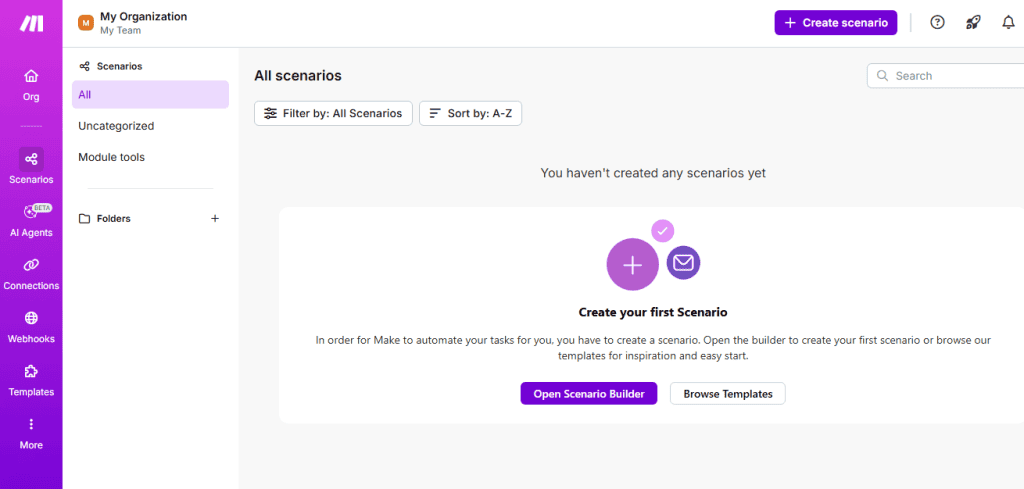
1. Visual Orchestration
Instead of manually coding integrations, you and your team can design workflows through an intuitive canvas. Every step of the process is visible, making it easier to map data flows, adjust logic, and document how systems interact. You can also collaborate since workflows can be shared and scaled without technical bottlenecks.
2. Make Grid
Make Grid, which is currently in beta, generates an automatic visual map of all workflows, AI agents, and data flows. You can track dependencies, troubleshoot issues, and maintain transparency. With real-time updates and filtering tools, you can quickly identify bottlenecks, monitor performance, and scale with confidence.
3. Flow Control and Data Manipulation
You can add conditional statements, loop through datasets, and adjust how tasks execute at each step. Its built-in data manipulation functions make it possible to reformat, transform, and clean data before it moves between systems. This ensures accuracy without the need for external tools.
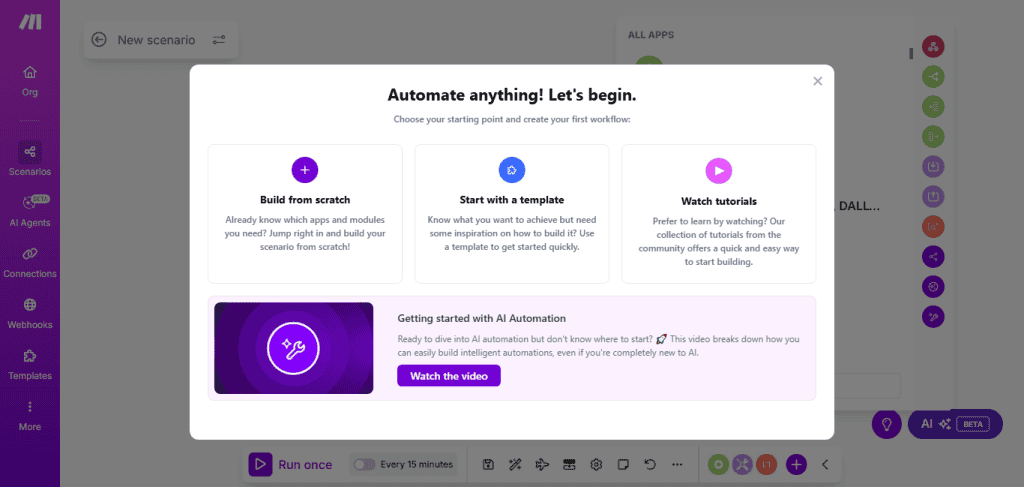
4. HTTP and Webhooks
One of Make’s strongest features is its API flexibility. You can connect to any service that supports HTTP requests or webhooks, which means even custom or niche apps can be integrated into workflows. This makes it possible to extend automation beyond the 2,500+ prebuilt apps in Make’s library.
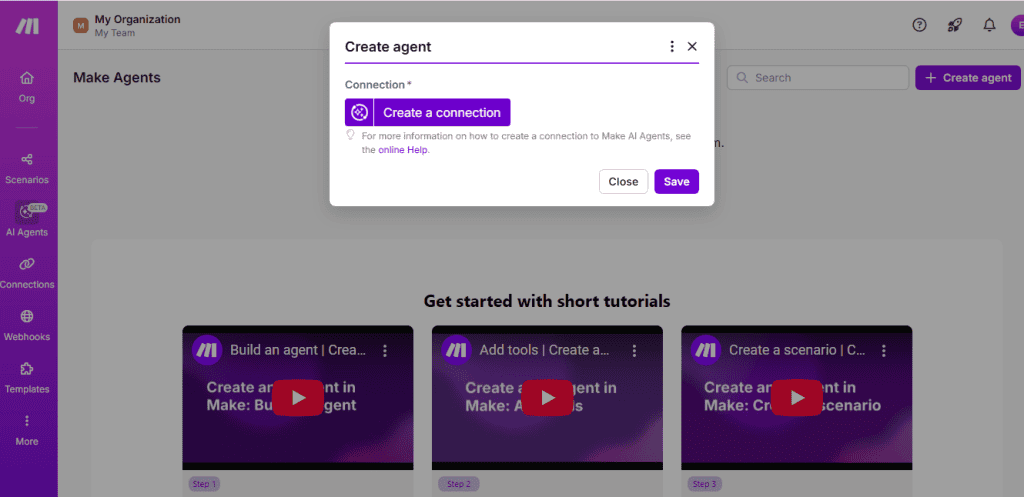
5. AI Agents and AI Tools
Make AI Agents, allows you to create reusable, intelligent modules that adapt in real time and can operate across multiple workflows. These agents are not static; they can analyze data, detect patterns, and make decisions on the fly.
In addition, Make includes ready-to-use AI tools such as summarization, categorization, and text generation. The best part is that you don’t need any prompt engineering expertise.
6. Observability and Analytics
To maintain performance at scale, Make provides an analytics dashboard that tracks how workflows are used and how they perform over time. You can monitor efficiency, measure outcomes, and identify where optimizations are needed. This visibility ensures that automation not only works but continues to add measurable value.
7. Enterprise Security and Governance
Make is built with enterprise-grade compliance and control. It supports GDPR and SOC 2 Type II standards, data encryption, and single sign-on (SSO) for secure access. Role-based controls allow administrators to set permissions and usage limits, while audit logs provide a full record of every workflow change for compliance purposes.
8. On-Premise and Advanced Enterprise Features
If your organization needs strict security, Make supports on-premise agents that allow local network access without exposing sensitive systems. Enterprise users also benefit from advanced workflow customization, dynamic connections that adapt to different environments, and deeper analytics for auditing and reporting.
Who Should Use Make?
Make is good enough to serve both individual users and large enterprises, but certain groups benefit the most from what it offers.
Small Businesses and Startups
Make is a cost-effective way to compete with larger players, so instead of hiring developers to build integrations, a small business can use Make’s visual builder to connect apps like Gmail, Slack, Shopify, and HubSpot in just a few clicks. The free plan and low-cost tiers make it accessible if you’re just starting out.
Marketing and Sales Teams
Make helps automate lead capture, sync data between CRMs, trigger campaigns, and even integrate AI tools for personalized outreach. This reduces manual work and ensures customer interactions move faster.
IT and Operations Teams
IT teams can use Make to orchestrate complex workflows across multiple systems and automate incident management. Because of its webhook and API support, it can integrate with custom apps or legacy software that other automation tools struggle with.
Enterprises with Complex Needs
Make’s Enterprise plan, with on-premise agents, role-based governance, and compliance standards, is designed for organizations handling sensitive data or operating across multiple departments. Large companies benefit from the visibility of Make Grid and the security controls built into the platform.
Freelancers and Solopreneurs
You can use Make to save time on invoicing, reporting, client communication, and task management. With access to 2,500+ apps, freelancers can create lightweight automations that handle the busywork, leaving them more time for other tasks.
AI-Driven Teams
Organizations experimenting with generative AI and intelligent agents will find Make especially valuable. Considering its AI Agents and 400+ AI app integrations, teams can go beyond traditional automation and build systems that analyze, adapt, and make decisions in real time.
Pricing and Plans
Make uses a credit-based system where each action inside a workflow consumes one credit.
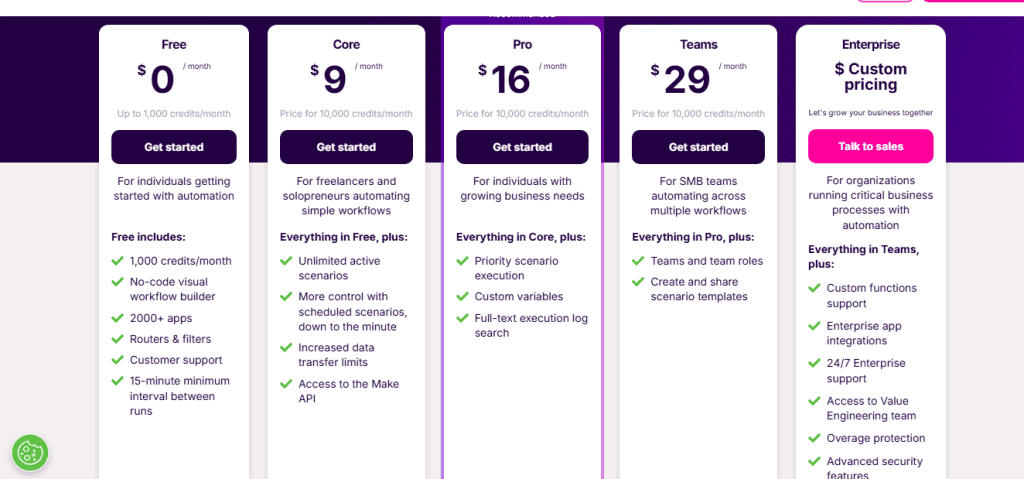
Free Plan
Cost: $0 per month
The free plan includes up to 1,000 credits monthly, basic access to the workflow builder, and all standard integrations. Runs are limited to every 15 minutes, which is fine for testing or light automation needs. This tier is best for individuals who are new to automation and want to explore the platform without commitment.
Core Plan
Cost: $9 per month (for 10,000 credits)
The Core plan is targeted at freelancers and solo professionals. It removes execution limits, supports scheduled runs down to the minute, and increases data transfer allowances. You will also gain access to the Make API for building more advanced workflows.
Pro Plan
Cost: $16 per month (for 10,000 credits)
The Pro plan adds faster execution, priority queuing, and advanced customization features such as custom variables and full-text search in execution logs. It is ideal for individuals or small teams that rely on automation as part of their daily operations and need more control over performance.
Teams Plan
Cost: $29 per month (for 10,000 credits)
The Teams plan introduce collaboration features such as role management, shared scenario templates, and greater data transfer capacity. It is designed for small to mid-sized businesses that want multiple team members building and managing workflows together.
Enterprise Plan
Custom pricing
The Enterprise plan unlocks the full power of Make with support for on-premise agents, enterprise-grade app integrations, advanced security tools like single sign-on, and 24/7 support. It also includes audit logs, overage protection, and access to a Value Engineering team for onboarding and strategy. This tier is built for organizations running mission-critical processes where uptime, compliance, and scalability are non-negotiable.
Pros and Cons
Pros
1. Generous Free Plan
The free plan with 1,000 monthly credits is one of the most flexible among automation platforms, making it easy for beginners to get started.
2. Highly Visual Workflow Builder
Make’s drag-and-drop interface allows you to design even complex automations without coding
3. Wide App Ecosystem
With more than 2,500 app integrations and strong API/webhook support, Make can connect mainstream tools like Gmail, Slack, and Google Sheets, as well as niche or custom software.
4. Cost-Effective Scaling
Plans are priced lower than competitors like Zapier at equivalent execution volumes. This offers better value for teams scaling their automation use.
5. Advanced Customization
Features like routers, iterators, error handlers, and AI agent integrations allow you to build sophisticated, multi-step workflows that adapt dynamically.
6. Strong Team and Enterprise Support
Collaboration tools, audit logs, and enterprise-grade security make it viable for organizations with strict compliance requirements.
Cons
1. Learning Curve for Beginners
The flexibility of Make can overwhelm new users who only need simple automations. It’s less beginner-friendly than tools like Zapier or IFTTT.
2. Credit-Based Billing Can Be Confusing
Understanding how credits are consumed may take time, and heavy workflows can deplete credits faster than expected.
3. Limited Support on Lower Plans
Email support is standard, but priority or dedicated support is locked behind higher tiers, which may frustrate smaller teams.
Make Alternatives
Zapier is one of the most popular alternatives to Make, especially for non-technical users who just want quick, simple automations. It has a massive library of prebuilt templates and integrations, making it easy to connect apps with minimal setup. Meanwhile Zapier tends to get expensive as your task volume increases, and it lacks the same depth of visual workflow customization that Make provides.
n8n is best for developers and teams that prefer self-hosting and maximum flexibility. It’s open source, which gives you complete control over your data and infrastructure. Unlike Make, you can add custom code inside workflows and even deploy on your own servers. However, this power comes with a steeper learning curve.
Pabbly Connect is a budget-friendly option that many agencies and small businesses choose when they want predictable costs. Its pricing isn’t based on per-task credits the way Make is, which makes it more attractive for high-volume workflows. On the downside, Pabbly doesn’t yet match Make’s advanced features like AI agentic automation or its vast enterprise-level governance options.
Integrately is designed for small businesses or individuals who just need straightforward automation. It’s easy to set up and has a large number of one-click workflows. Compared to Make, however, it’s more limited when it comes to complex logic, routing, or advanced real-time monitoring.
Microsoft Power Automate is a strong choice for organizations already using Microsoft 365, Azure, or Dynamics. It integrates deeply with Microsoft’s ecosystem and offers powerful robotic process automation (RPA) features. Where it falls short is in accessibility for smaller teams. Its pricing and licensing can be complex, and the platform can feel heavy if you’re not already invested in Microsoft products.
Tray.io is another enterprise-oriented alternative that balances visual workflow building with strong API integration. It’s great for mid-sized and large businesses that want to connect multiple complex systems. However, it’s more expensive than Make and has a learning curve that smaller teams may find unnecessary if they only need simple automations.
Conclusion
In conclusion, Make stands out as one of the best automation platforms available today. Its visual workflow builder, extensive app library, and integration of AI capabilities make it a powerful solution for individuals, startups, and large enterprises alike. While competitors like Zapier and Pabbly may be easier for beginners or more affordable for high-volume tasks, Make strikes a strong balance between usability and advanced customization.
If you’re a freelancer, you’ll enjoy an affordable way to streamline repetitive work. As a team or enterprise, you’ll enjoy governance, scalability, and security features that support complex automation at scale. The credit-based pricing model requires some planning, but it also ensures flexibility for different levels of use.
If you are looking for an automation tool to experiment with AI-driven workflows, Make is one of the best choices in 2025.
FAQs
1. Is Make only for tech-savvy users, or can beginners use it too?
Make has a drag-and-drop interface which makes it accessible to non-coders. Beginners can start small with pre-built templates before exploring more complex workflows.
2. How does Make’s credit system impact real-world usage?
Each action within a workflow consumes credits. This means high-frequency or data-heavy tasks may use credits faster.
3. Can Make replace the need for a developer in automation projects?
For simple workflows, yes, Make eliminates the need for coding. However, in enterprise scenarios involving custom APIs, data-heavy processes, or unique system integrations, developers still play an important role in extending Make’s capabilities.
4. How does Make incorporate AI in its workflows?
Make integrates with 400+ AI apps and provides tools like AI Agents, AI Toolkit, and AI-powered assistants.
5. Can Make be used alongside other automation platforms?
Yes. Some businesses use Make together with Zapier, n8n, or custom-coded systems depending on the task. Make is often chosen when workflows require high flexibility, AI orchestration, or deep customization.

